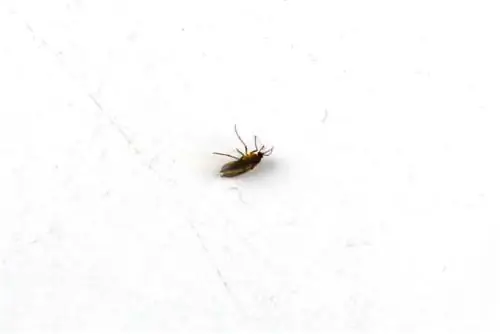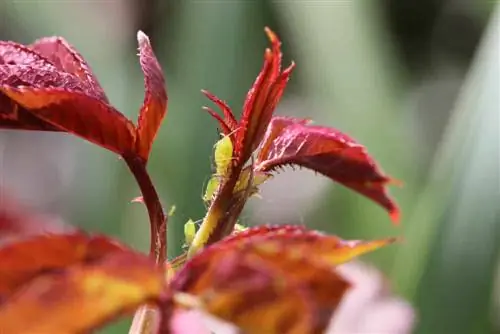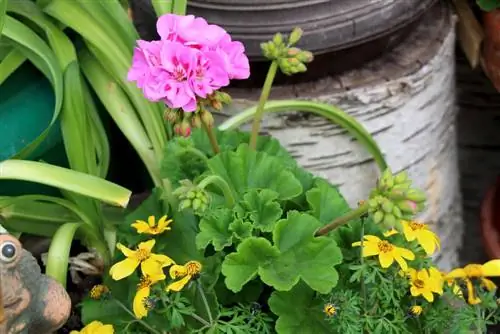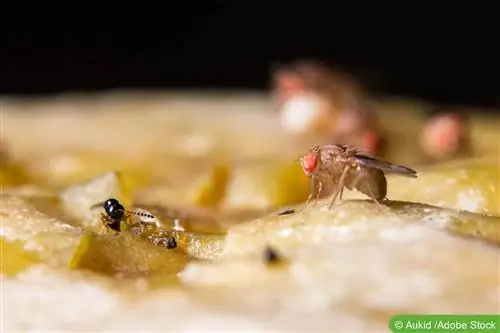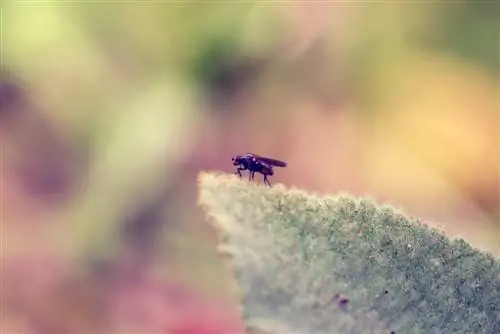- Author admin [email protected].
- Public 2023-12-17 03:39.
- Last modified 2025-06-01 06:48.
If small flies appear in the apartment, you have to act quickly because, no matter what species they are, they usually multiply very quickly and often become a real nuisance. They are usually fruit flies, also known as fruit flies or vinegar flies, or fungus gnats. While fruit flies are mainly found on fruit left outside, fungus gnats like to settle on plant soil and buzz around flower pots. Both types of pests have different lifestyles and are combated using different methods.
Fruit flies
Fruit or fruit flies appear mainly in the summer and autumn months and usually in the kitchen or around fruit bowls. The insects, which are only 2 to 4 mm in size, like open drinks bottles, rubbish, of course fruit, especially ripe ones, and leftover food. After they have reproduced, they buzz around the entire apartment, always looking for food.
The little flies come into the house in various ways, through the open window, through shopping, mainly fruit. The females lay their eggs, up to 400 of them, preferably on fruit. The small larvae feed on the pulp. Because they are so tiny, we humans usually overlook them and eat them. At ideal temperatures, around 25°C, the larvae hatch after just 24 hours. After just 9 more days, the fruit fly is fully developed. So you can imagine why a few fruit flies turn into entire hordes within a few days.
Fighting fruit flies
There are different ways to get rid of fruit flies. It is important to start combating them in good time, before they can multiply.
Yellow boards or yellow stickers
The flies are attracted to the bright yellow plugs, sit on them and stick to the sticky surface. They can't get away anymore. The glue traps are effective and poison-free.
Carnivorous plants
Feed on small insects, but cannot cope with masses of them.
Funnel traps
Consist of an attractant and a trap in the shape of a funnel that makes escape almost impossible. It's effective, but far too expensive for a purchase price of around 10 euros.
Suck away with the vacuum cleaner
This is particularly helpful in the event of a mass infestation. You won't catch them all, but they will be significantly reduced. Small handheld vacuum cleaners are also cheap.
Fruit fly killer for the socket
The flies are attracted with a special UV lamp and destroyed by an integrated high-voltage grid. One plug is enough for a room of around 20m².
Make your own alternatives
- Set up a bowl with 3 parts fruit juice, 1 part vinegar, 2 parts water and a drop of dishwashing liquid. Place these where most flies appear, usually next to the fruit basket. The fruit flies are attracted and land on the liquid. The detergent ensures that the surface tension does not carry the insects. They fall into the liquid and drown.
- You can use sugar instead of juice, along with water and dishwashing liquid. You don't have to spend 10 euros on it. However, it is important that all eating alternatives are put away. There should be nothing else standing around that is interesting to the flies.
- Sparkling wine also has this effect. Simply pour a larger sip into a bowl and set it up. Wine works the same way, red wine works better than white wine. Don't forget the dishwashing detergent!
Prevent fruit flies
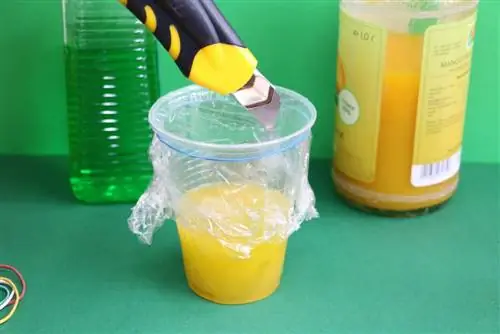
There are all kinds of things you can do to prevent fruit flies. The introduction of the pests, usually with fruit, cannot be prevented. However, this only causes a few problems if the insects cannot find food. Therefore, fruit should be stored in the refrigerator in summer and autumn if possible. In addition, the garbage must be emptied more often or closed with a lid. If you don't have space in the fridge, you should cover the fruit just to prevent the eggs from being placed on it. Cleanliness is important. Leftover food, dirty plates standing around, dropped food, all of this is ideal for fruit flies. They can be easily limited by cleanliness. Beverage bottles should never be left open. Water may be safe, but it is the power of habit.
Sad gnats
If the small flies are not after fruit and sweet drinks, but are mainly around flower pots and on soil, then they are probably fungus gnats. At first glance they look like small flies, but they are fungus gnats, also known as fungus gnats. These little pests lay their eggs in potting soil and the larvae can cause damage to the roots. The parent animals are usually seen as a nuisance because they buzz around everywhere. But they are quite easy to fight. Things get a little more difficult with the larvae in the soil.
Sad gnats are similar to fruit flies. The best way to distinguish them is under a microscope. The larvae show clear differences. The fungus gnats are significantly larger, can be seen with the naked eye, up to 5 mm long, maggot-shaped, whitish in color with a black head. Some plants that are weak and do not develop and grow well have the larvae in the soil. It may be worth taking a look.
Fighting fungus gnats
When it comes to fungus gnats, a clear distinction must be made as to whether they are the adults or the larvae. They are fought differently. Not all remedies help consistently, sometimes it makes sense to try different ones.
Adult fungus gnats
- Yellow sticker or yellow boardln - these are stuck directly into the potting soil. The bright yellow color attracts the insects, they sit down and stick. The sticky traps are poison-free and effective. If there is a severe infestation, the stickers must be replaced regularly so that there is always enough space on them. In addition, they have to be left standing for weeks so that subsequent generations are also eliminated.
- Suction - simply suck away the insects buzzing around with the vacuum cleaner. This method is effective even if not all pests are caught.
- Fly swatter - you can also kill the mosquitoes as soon as they sit down, preferably at the window or next to the planters
Sickness Gnat Larvae
The larvae can be combated in various ways, from simple home remedies to roundworms, bacteria and predatory mites to chemical agents. Sometimes you have to experiment a bit before you find a good solution.
- Matches stick your head into the plant soil. The sulfur content in the ignition head kills the larvae in the soil. However, the matches need to be replaced after a few days. It is also helpful to keep the soil drier.
- An approximately 1 cm thicklayer of sand on the potting soil prevents the female mosquitoes from laying their eggs. This must be evenly thick. Keep the soil underneath drier
- Plants onlywater from below, i.e. over the saucer or planter. Not all plants like this, but you should try it. This keeps the surface in the vessel drier. Add sand on top and the situation will improve.
- Pour a mixture of lukewarm water, baking soda, a little oil and a little s alt directly onto the potting soil.
- Close potting soil for 4 to 5 weeks. It's best to put the entire flower pot in a nylon stocking and close it at the top or tightly around the trunk. The water drainage holes must also be closed. This means that no flies come to the ground to lay eggs and no newly hatched larvae come out of the ground. The cycle cannot continue and subsequent generations will no longer come together.
- Parasitic nematodes - small nematodes that are added to the irrigation water and then attack the maggots in the flower pot and cause them to die. Nematodes are absolutely harmless to humans and pets. You can order them online or in a hardware and garden store. After watering, it takes 2 to 3 weeks for them to do their job. Steinernema feltiae are the most suitable. If the infestation is severe, the treatment should be repeated after about 4 weeks. The substrate must not dry out during the entire treatment period.
- Bacteria - especially Bacillus thuringiensis var. israelensis (BTI), also kill the larvae. They are also introduced into the soil via irrigation water. The bacteria form permanent spores with protein crystals, which are toxic to the pests. Like nematodes, bacteria can also be purchased commercially.
- Predatory mites - feed on the larvae of the fungus gnat. Hypoaspis miles are particularly useful for use in greenhouses and enclosed winter gardens. They live in the upper layers of the soil and hunt the larvae there. They only stop when there are no more. After a while the mites also die.
- Chemical agents should only be used inemergencies. As a rule, they are not necessary. There are a wide variety of insecticides available commercially. You have to get advice on this. Every year funds are withdrawn from the market or new ones are added.
- Remedies that are used against mosquitoes in garden ponds or other stagnant bodies of water are also helpful. You add these to the irrigation water and they are simply killed. When it comes to remedies, there are also quite harmless ones without harmful ingredients, at least for people and pets.
Preventing fungus gnats
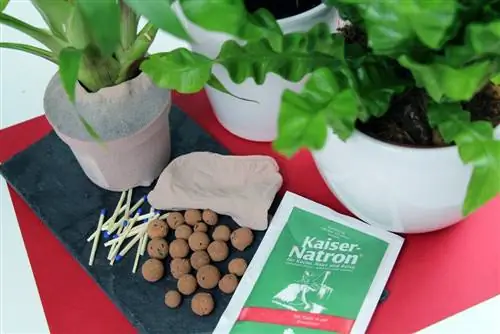
Prevention is not easy because the mosquitoes get inside through open windows and the larvae are also in containers that have been left outside over the summer. They can also be easily brought in. Fungus gnat eggs are often found in fresh planting substrates. In this particular case, it makes no difference whether you buy cheap or expensive soil. The eggs are even in organic soil, which is because the different types of fungus gnats are quite useful. They are therefore particularly common in organic farms.
The best way to prevent it is to not keep houseplants too moist. Fungus gnats don't like dry soil. If the top layer of soil is nice and dry, the mosquitoes will not settle. That's why a decent layer of sand on the ground is a good basis. Quartz sand is particularly suitable. Bird sand, on the other hand, should not be used.
Plant pots with an irrigation system have proven to be beneficial. Once established, the plants draw the water they need from the reservoir below, the upper layer of soil hardly ever comes into contact with water and stays nice and dry. In addition, sand from above can help, so the mosquitoes have no chance.
It is also helpful to treat new plant soil with heat in the microwave or in the stove. Insect eggs are killed. Depending on the amount and wattage of the microwave, the earth should be heated for 2 to 5 minutes. The soil is spread on a tray in the oven and heated at 100 degrees for about half an hour. This kills larvae, regardless of species. Hydroponics is also extremely cheap. There is no earth anymore.
The mini flies are really unpleasant. Regardless of whether it is a fruit fly or a fungus gnat, the insects are annoying, especially when they have multiplied heavily and appear in large numbers. The vacuum cleaner is a good solution to initially contain them in quantity. Then the causes must be examined. In the case of fruit flies, all fruit must be removed, as well as leftover food and open garbage. You can't find anything edible anymore. For fungus gnats, the moist soil needs to be reduced, with less irrigation water and a layer of sand. These measures help a lot. If there are remaining populations, a trap with a home-made sweet cocktail with dishwashing liquid can help with the fruit flies. It attracts them and kills them by drowning. Yellow signs also reduce pests. When it comes to fungus gnats, there are a variety of simple ways to get rid of the insects. You just have to stay on the ball.

